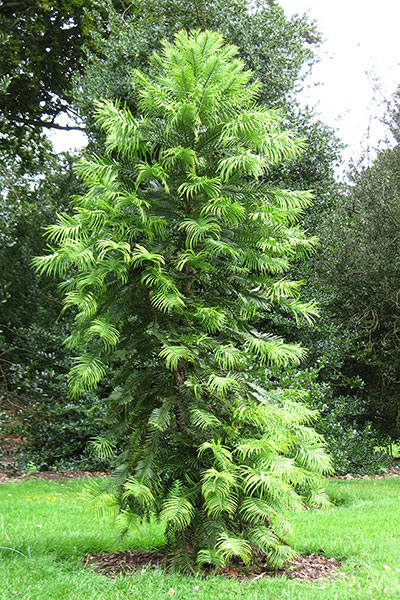General Description:
The story of the discovery of the Wollemi Pine has been well publicised and full details can be viewed at the links below. In short, National Parks and Wildlife office, David Noble, discovered the plant while bushwalking in an isolated area of the Wollemi National Park. He recognised it as being unusual and took a specimen for later identification. Various botanists examined the specimen and visited the trees in the wild. The plant was subsequently recognised as a new species with its nearest living relatives being conifers in the Araucariaceae family, including the Bunya Pine (Araucaria bidwillii), Hoop Pine (Araucaria cunninghamii) and the Queensland Kauri (Agathis robusta). The plant was named Wollemia nobilis in recognition of both its location and discoverer.
There are widespread examples of plants similar to Wollemia in the fossil record from Australia, New Zealand and Antarctica dating from the time of the dinosaurs. The plant soon became known as a living fossil or the ‘dinosaur tree’.
The discovery of this new species caused considerable interest worldwide and to protect the natural population (numbering about 100 trees in three geographically close locations) from the possibility of disease, the actual locations were not publicised and restrictions on entry to unauthorised people were implemented. Despite this, some trees have been found to be infected with the root pathogen, Phytophthora cinnamomi, undoubtedly introduced by trespassers.
Because of worldwide interest in the plant and to reduce the incentive for collectors to visit the remote location to remove propagating material. a large scale propagation program was implemented by the Royal Botanic Gardens, Sydney, in association with a commercial grower.
Wollemia nobilis is a tree reaching 25 – 40 metres high in its natural habitat. The bark is dark brown and has a “bubby” appearance which is quite unlike any related species. The leaves are flat, linear in shape to about 80 mm long by 5 mm wide. Side branches often terminate in a cylindrically-shaped male or female cone about 10 cm long. The female cones eventually break up to release seeds.
The first cultivated Wollemi Pine was planted at the Royal Botanic Gardens, Sydney, in February 1998 and plants were subsequently planted at other botanic gardens throughout Australia and overseas. Plants were first released for sale to the general public in April 2006.
As W.nobilis has been in general cultivation for a relatively short time, its suitability for cultivation is still being assessed. Experience to date suggests that it will adapt satisfactorily to many areas, in much the same way as the related Bunya Pine, Norfolk Island Pine and Hoop Pine. It appears to have a definite growth ‘spurt’, being dormant over the colder months and quickly putting on new growth during spring through to early summer. The plant makes a very attractive plant for growing in a large container where, with care and attention, it will thrive for many years.
W.nobilis apparently germinates well from seed without pretreatment but seed is not available to the general public. Propagation from cuttings is also successful but propagating material is scarce and will remain so until those plants that were released to the public in 2006 develop into reasonably large specimens.
Further Information
- James Woodford. The Wollemi Pine: The incredible discovery of a living fossil from the age of the dinosaurs. The Text Publishing Company, 2002
- Wollemi Pine Conservation Program
- Wollemia nobilis: EPBC Act Status and Documents
- Wollemi Pine Official Site
* EPBC Act = Environment Protection and Biodiversity Conservation Act 1999;
ROTAP = Rare or Threatened Australian Plants (Briggs and Leigh, 1988)
For further information refer the Australian Plants at Risk page

A specimen of Wollemia nobilis at Kew Gardens in
Great Britain
Photo: Architeuthis Dux from Wikimedia Commons
and reproduced under the Attribution-ShareAlike 3.0
Unported License (CC BY-SA 3.0)

Male cone on young Wollemi Pine
Photo: Brian Walters

Female cone on young Wollemi Pine
Photo: Brian Walters
Other Native Plant Profiles
 Australian Native Plants Society (Australia)
Australian Native Plants Society (Australia)













